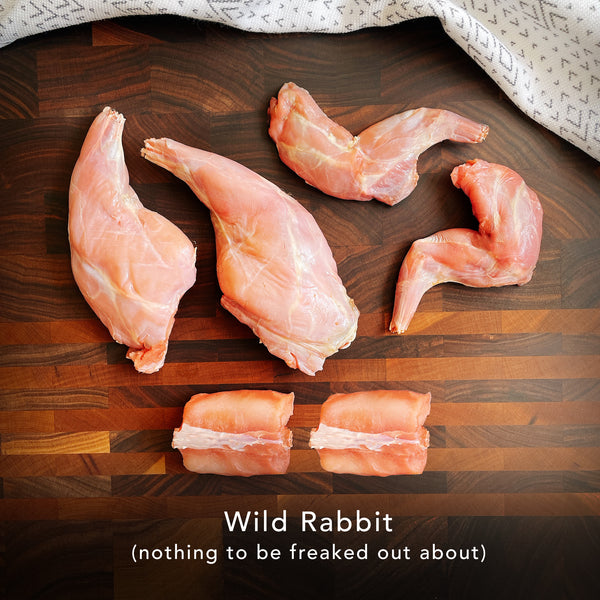Pici Pasta With A Wild Rabbit And Pesto Ragù

Introduction
We can understand why some people, bunny owners in particular, are squeamish about eating rabbit. As with so many foods (frog legs and snails being the obvious ones), our friends on the continent are far more relaxed when it comes to eating things that in the UK are considered unusual.
The fact is, wild rabbits, despite being cute, are officially considered pests due to their lightening reproduction speed and ability to cause significant destruction to agricultural crops, vegetable gardens, and plant borders. They also happen to be lean, affordable, and exceptionally tasty, so we happily tuck into them whenever we can without an ounce of guilt.

We think once you've tasted our rabbit ragù with an added dollop of pesto, you'll be a convert and never be satisfied with a beef ragù again.
As for our choice of pasta, well, pici was new to us when we took a trip to Tuscany where we found it being served with pretty much any sauce under the sun. It’s basically linguine’s fatter cousin, so chubby that it takes a little longer to cook and, in many ways, bears more similarities to Asian udon noodles than Italy's more famous pasta shapes.

Recommended equipment
Casserole dish
Digital kitchen scales
Pro tip
While it seems counterintuitive to add anything fish-based to your meaty ragù, we urge you not to skip the fish sauce. Not only does this fermented anchovy liquor add a ton of savouriness but it also has the super-human ability to make meat taste meatier without adding even a slight hint of fishiness. One day, we'll get our heads around the science behind this amazing freak of nature.

Ingredients for four
| Pasta | 300g |
| Wild rabbit | x1 |
| Tomatoes | x2 tins |
| Onion | x1 |
| Carrots | x1 |
| Celery rib | x1 |
| Garlic | x4 cloves |
| Red wine | 125g |
| Pesto | 50g |
| Sherry vinegar | 10g |
| Fish sauce | 15g |
| Pancetta | 100g (optional) |
| Dried mushrooms | 5g (optional) |
| Dried oregano | 1g (optional) |
| Tomato paste | 10g (optional) |
| Bay leaves | x2 |
| Seasoning | as needed |
| Parmesan | as needed |
| Fresh herbs | as needed |
| Oil | as needed |
Method
Your life will be a lot easier if you can source pre-butchered rabbit legs, but in the UK, it's much more common to find whole frozen rabbits. All the gory stuff (skinning, gutting, etc.) will have already been done, leaving you to simply remove all four legs and separate the ribs from the saddle. There are plenty of videos online showing the process, and it really is no great hardship.
Add a generous glug of oil to a casserole dish and heat on a hob until the oil is shimmering and just starting to show wisps of smoke. Add the rabbit and sear until nicely browned all over. Remove it and set aside.
Peel and finely dice the carrots, onion, and celery, and add them along with the pancetta to the casserole dish. Sauté on a low heat until softened but not browned, about 10-15 minutes.
Crush the garlic and add, continue cooking for another 2 minutes, then whack up the heat, add the wine (we favour a full-bodied red wine like Malbec or Chianti), and cook off the alcohol.
Add the bay leaves, fresh herbs (rosemary, sage, and thyme are a winning trilogy), tomatoes, vinegar, oregano, mushrooms, and rabbit to the dish and cover securely with a lid or tinfoil. Simmer on the lowest heat you can muster (or cook in a 160°C oven) for 2-3 hours, or until the rabbit meat is beautifully tender and starting to fall off the bone.
Remove the meat from the casserole dish and allow it to cool slightly. Shred the meat from the bone, either keeping it chunky or super fine; your call. Make doubly sure to remove all the bone fragments, as there's nothing more disappointing than getting a fragment of bone stuck in your tooth after all this effort.
Add the shredded meat back to the saucepan and keep warm while you cook your pasta.
Add the pasta to a pan of salted water and cook until al dente, about 12-14 minutes. Add the pasta to the sauce along with the pesto and stir well. Plate up, adding a generous amount of Parmesan before devouring and wondering how you've ever lived without this incredible dish in your culinary repertoire.
